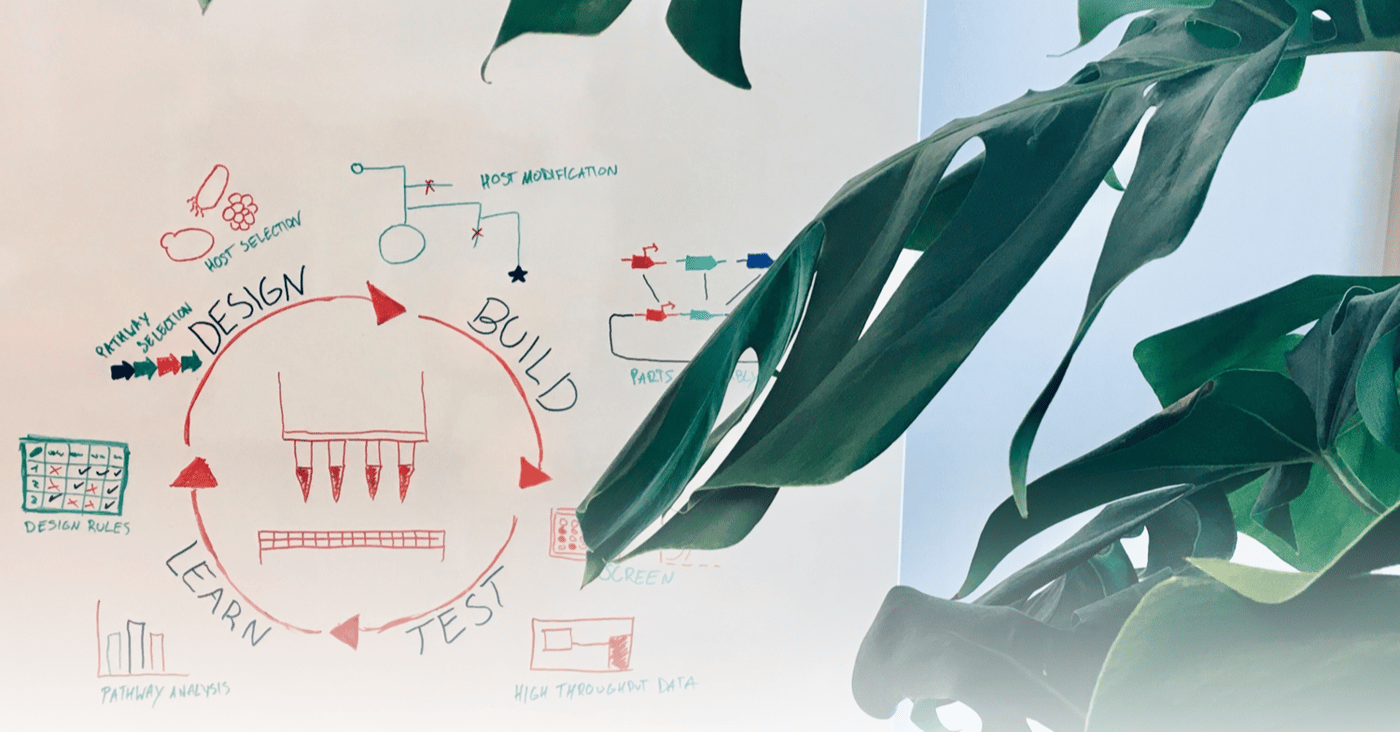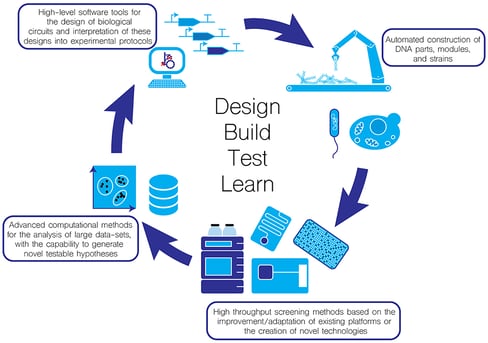Who Holds the Keys to the Future of Synthetic Biology?

Posted by:
Laura Turpeinen
Published on:
Dec 1, 2019
Few life science sectors are gaining economical traction in the same way as synthetic biology. Advancements in genome sequencing and engineering technologies allow us to create custom genetic constructs and reprogram living organisms, opening up new ways to produce drugs, chemicals, biofuels, materials and much more. According to Forbes, the synthetic biology industry has raised over US$12 billion in funding in the past 10 years, with US$4 billion in 2019 alone. But for the industry to truly take off, the field needs a technological jolt.
Challenges in engineering biological systems
Together with systems biology, synthetic biology is a platform for translating advances in genomics, proteomics and molecular biology into real-world applications.
The key to this production-orientated approach is applying engineering design principles to biology. Synthetic biology uses molecular biology protocols to design, build and test new genetic constructs that express a desired product. Through continuous improvement, engineering biological systems with custom functionalities should become increasingly dynamic and inexpensive for future industries.

Figure 1. Design-Build-Test-Learn cycle at the heart of synthetic biology (Source).
Yet despite its elegance, the design-build-test-learn cycle is all but straightforward. Making these engineering steps work seamlessly is key to production success, which requires instruments and workflows with uniform standards. Synthetic biologists therefore need to collaborate with teams of automation engineers, fluidics experts, computer scientists, software designers and regulatory advisors to bring their solution to the market. This interdisciplinarity brings its own challenges as biologists, used to the messiness of complex biological of systems, are now expected to guarantee production efficiency and predictability.
By its nature, synthetic biology relies on trial and error. Reaching a desired phenotype through continuous debugging and reprogramming can require designing, testing and screening 100,000s of gene variants. While computers have automated data collection, most workflows in mutagenesis, mutant characterization and candidate enrichment mainly rely on manual labor. The need to generate and analyze high-throughput, reliable and reproducible experimental data calls for laboratory automation.
How will instrument providers catalyze synthetic biology?
Robotics can be used to automate virtually all aspects of synthetic biology workflows. This includes next-generation sequencing, DNA extraction, PCR set-up and clean-up, cell transformation and transfection, colony picking, biochemical and cell-based assays, and protein purification and expression screening. New automated instruments will enable:
1. Scaling up
Incorporating programmable tools is essential for any industrialization process and also for synthetic biology. Programmable robotics and workflow automation are the sorely needed assembly lines that will ramp up synthetic biology to a commercial scale. Whether these are liquid handlers, sample purifiers or custom incubators, any solutions for eliminating manual steps will be more than welcome.
Furthermore, performing reactions in small volumes and increasing throughput through standardized microfluidic cartridges (or lab-on-a-chip devices) will increase the turnover of results. As an example, a UC Berkeley team described a programmable, automated microfluidic platform on which DNA libraries can be seamlessly designed, constructed, transformed into a host chassis and screened for desired functionality. Similar end-to-end technologies built on cell-free in vitro environments will eliminate the need for organism-specific technologies and create more predictable manufacturing platforms for scale-up production.
2. Quality control
Synthetic biology relies on developing reproducible data on a massive scale. Once a useful gene circuit has been established, synthetic biologists need to arrive at the same result again and again with minimum variability and, ideally, so that anyone can reproduce the same end goal. Biologists estimate that only 59% of publications contain reproducible results, an alarming statistic which currently includes the developments of new gene therapies and genome editing tools. Further, most methods in synthetic biology projects are unstandardized, tedious, repetitive and highly error-prone for humans, but ideal for robotics. Standardized tools and protocols will especially improve the quality control required for healthcare applications of synthetic biology.
3. Innovation
Most importantly, workflow automation will lower accessibility barriers and transform synthetic biology into a field of open innovation. Robotic instruments enabled cheap and fast genome sequencing within 20 years, and the same is expected for genome synthesis. A revolution in automated laboratory tools will allow more students, researchers as well as start-ups and large companies to create unprecedented future solutions for industries, medicine and the environment.
Where are the automation bottlenecks?
Since the field of synthetic biology itself is composed of multiple parts, simplifying synthetic biology workflows into a single instrument is the holy grail for instrument developers. However, since the field is in an early state of flux, new molecular methods could make trendy instruments useless. Therefore, it’s understandable for life science instrument providers to feel uncertain about where the field is going and where to invest.
Fortunately, nearly all work around synthetic biology revolves around DNA manipulation. This means that every breakthrough tool in the following areas will make the genetic code cheaper, easier and safer to handle and consequently impact the entire industry:
1. Genome sequencing
Quick and accurate genome sequencing is essential for true verification of engineered synthetic constructs. Methods to look out for include automating NGS workflows. However, these are limited to a specific base pair range (see Table 1 below). A transition into targeted amplicon sequencing would be ideal for high-throughput organism engineering, since it is more cost-effective and would deliver a higher coverage, allowing for detection of rare variants, whereas long-read and whole exome sequencing would be better suited for genome therapy and personalized medicine.

Table 1. Comparison of read lengths, error rates and costs of various DNA sequencing technologies (Source).
2. DNA synthesis and assembly
Synthesis of desired strands of DNA or RNA is a key method in synthetic biology in need of laboratory automation. Automating steps within the DNA assembly and production workflow will bring down the cost of DNA design and ordering. Though not yet commercially available, advancements circle around enzymatic DNA synthesis, which would create longer nucleotide reads than chemical synthesis and be more environmentally friendly. Indeed, the whole industry is still waiting for a custom DNA printer that would enable researchers and companies to produce their own DNA on the spot without outsourcing. This will become increasingly important for the increase in DNA-based data storage as well as concerns over data privacy and ownership.
3. Genome editing
The example of programmable CRISPR/Cas9 engineering arising from a virtually unknown tool seven years ago to changing how we carry out mutagenesis shows the dynamics of the synthetic biology field. Discovering new Cas enzyme variants like Cas13 or Cpf1 expands targeted DNA editing into RNA editing and nucleic acid detection, improving overall editing specificity and offering an unprecedented range of applications.
Now, CRISPR tools are moving from a handcraft to industry-grade instrumentation. Various steps in genome engineering workflows can be simplified through automation: guide RNA design and synthesis, transfection and transformation and analysis. Importantly, improvement is needed in editing efficiency and accuracy. CRISPR still has a risk of off-target effects, making validation testing paramount for gaining public trust.
The bottom line
Even in life sciences, the driving omics is still economics. Though flooded with investments, the synthetic biology industry faces a vast technological challenge in order to fully realize its potential. Here, instrument providers have a unique opportunity to become enablers of progress.
As seen with NGS technologies, the need to analyze, write and edit DNA using automated tools is likely to accelerate. However, it’s easy to become overwhelmed when considering which of all the possible workflow steps to automate first and how to remain relevant in the next five years.
To learn more about synthetic biology automation, check out the 3x3x3 info cube we’ve prepared below.
📚 3 Synbio Books
What’s Your BioStrategy
Regenesis: How Synthetic Biology will Reinvent Nature and Ourselves
Synthetic Biology – A Primer
📃 3 Synbio Publications
El Karoui, M., et al. (2019). Future Trends in Synthetic Biology—A Report. Frontiers in Bioengineering and Biotechnology, 7.
Linshiz, G., et al. (2016). End-to-end automated microfluidic platform for synthetic biology: from design to functional analysis. Journal of Biological Engineering, 10(1).
Jessop-Fabre, M. and Sonnenschein, N. (2019). Improving Reproducibility in Synthetic Biology. Frontiers in Bioengineering and Biotechnology, 7.
📹 3 Synbio Webinars
Future of the Genomic Editing Revolution – Prof George Church - CRISPRSynthetic Biology: Programming Living Bacteria – Christopher Voigt
High Throughput Synthetic Biology: Synthesizing Designer Yeast Through Automation and Acoustic Liquid Handling
